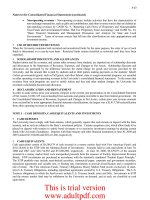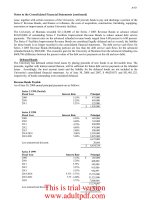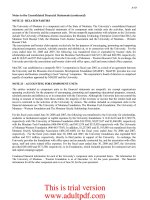MARCH 2011 HILLSBOROUGH COMMUNITY COLLEGE A COMPONENT UNIT OF THE STATE OF FLORIDA NOTES TO pot
Bạn đang xem bản rút gọn của tài liệu. Xem và tải ngay bản đầy đủ của tài liệu tại đây (273.97 KB, 8 trang )
MARCH 2011 REPORT NO. 2011-164
HILLSBOROUGH COMMUNITY COLLEGE
A COMPONENT UNIT OF THE STATE OF FLORIDA
NOTES
TO FINANCIAL STATEMENTS (CONTINUED)
J
UNE 30, 2010
28
30 years using the level percentage of projected payroll method. The remaining amortization period at June
30, 2010, was 27 years.
11. RETIREMENT PROGRAMS
Florida Retirement System
. Essentially all regular employees of the College are eligible to enroll as
members of the State-administered Florida Retirement System (FRS). Provisions relating to FRS are
established by Chapters 121 and 122, Florida Statutes; Chapter 112, Part IV, Florida Statutes; Chapter 238,
Florida Statutes; and Florida Retirement System Rules, Chapter 60S, Florida Administrative Code; wherein
eligibility, contributions, and benefits are defined and described in detail. FRS is a single retirement system
administered by the Department of Management Services, Division of Retirement, and consists of two
cost-sharing, multiple-employer retirement plans and other nonintegrated programs. These include a
defined-benefit pension plan (Plan), a Deferred Retirement Option Program (DROP), and a
defined-contribution plan, referred to as the Public Employee Optional Retirement Program (PEORP).
Employees in the Plan vest at six years of service. All vested members are eligible for normal retirement
benefits at age 62 or at any age after 30 years of service, which may include up to 4 years of credit for
military service. The Plan also includes an early retirement provision; however, there is a benefit reduction
for each year a member retires before his or her normal retirement date. The Plan provides retirement,
disability and death benefits, and annual cost-of-living adjustments.
DROP, subject to provisions of Section 121.091, Florida Statutes, permits employees eligible for normal
retirement under the Plan to defer receipt of monthly benefit payments while continuing employment with
an FRS employer. An employee may participate in DROP for a period not to exceed 60 months after
electing to participate. During the period of DROP participation, deferred monthly benefits are held in the
FRS Trust Fund and accrue interest.
The State of Florida establishes contribution rates for participating employers. Contribution rates during the
2009-10 fiscal year were as follows:
Class Percent of Gross Salary
Employee Employer
(A)
Florida Retirement System, Regular 0.00 9.85
Florida Retirement System, Senior Management Service 0.00 13.12
Deferred Retirement Option Program - Applicable to
Members from All of the Above Classes or Plan 0.00 10.91
Florida Retirement System, Reemployed Retiree (B) (B)
Notes: (A)
(B)
Employer rates include 1.11 percent for the postemployment health
insurance subsidy. Also, employer rates, other than for DROP
participants, include 0.05 percent for administrative costs of the Public
Employee Optional Retirement Program.
Contribution rates are dependent upon retirement class in which
reemployed.
This is trial version
www.adultpdf.com
MARCH 2011 REPORT NO. 2011-164
HILLSBOROUGH COMMUNITY COLLEGE
A COMPONENT UNIT OF THE STATE OF FLORIDA
NOTES
TO FINANCIAL STATEMENTS (CONTINUED)
J
UNE 30, 2010
29
The College’s liability for participation is limited to the payment of the required contribution at the rates and
frequencies established by law on future payrolls of the College. The College’s contributions for the fiscal
years ended June 30, 2008, June 30, 2009, and June 30, 2010, totaled $3,264,328, $3,407,448, and $3,470,635,
respectively, which were equal to the required contributions for each fiscal year.
As provided in Section 121.4501, Florida Statutes, eligible FRS members may elect to participate in the
PEORP in lieu of the FRS defined-benefit plan. College employees already participating in the State College
System Optional Retirement Program or the DROP are not eligible to participate in this program.
Employer contributions are defined by law, but the ultimate benefit depends in part on the performance of
investment funds. The PEORP is funded by employer contributions that are based on salary and
membership class (Regular Class, Senior Management Service Class, etc.). Contributions are directed to
individual member accounts, and the individual members allocate contributions and account balances among
various approved investment choices. Employees in PEORP vest at one year of service. There were 188
College participants during the 2009-10 fiscal year. Required contributions made to the PEORP totaled
$806,505.
Financial statements and other supplementary information of the FRS are included in the State’s
Comprehensive Annual Financial Report, which is available from the Florida Department of Financial
Services. An annual report on the FRS, which includes its financial statements, required supplementary
information, actuarial report, and other relevant information, is available from the Florida Department of
Management Services, Division of Retirement.
State College System Optional Retirement Program
. Section 1012.875, Florida Statutes, provides for an
Optional Retirement Program (Program) for eligible college instructors and administrators. The Program is
designed to aid colleges in recruiting employees by offering more portability to employees not expected to
remain in the FRS for six or more years.
The Program is a defined-contribution plan, which provides full and immediate vesting of all contributions
submitted to the participating companies on behalf of the participant. Employees in eligible positions can
make an irrevocable election to participate in the Program, rather than the FRS, and purchase retirement and
death benefits through contracts provided by certain insurance carriers. The employing college contributes,
on behalf of the participant, 10.43 percent of the participant’s salary, less a small amount used to cover
administrative costs. The remaining contribution is invested in the company or companies selected by the
participant to create a fund for the purchase of annuities at retirement. The participant may contribute, by
payroll deduction, an amount not to exceed the percentage contributed by the college to the participant’s
annuity account.
There were 105 College participants during the 2009-10 fiscal year. Required employer contributions made
to the Program totaled $712,164.
This is trial version
www.adultpdf.com
MARCH 2011 REPORT NO. 2011-164
HILLSBOROUGH COMMUNITY COLLEGE
A COMPONENT UNIT OF THE STATE OF FLORIDA
NOTES
TO FINANCIAL STATEMENTS (CONTINUED)
J
UNE 30, 2010
30
12. CONSTRUCTION COMMITMENTS
The College’s construction commitments at June 30, 2010, are as follows:
Project Description Total Completed Balance
C
omm
itt
e
d
t
o
D
a
t
e
C
omm
itt
e
d
Ybor City Auto Mechanic Facility Renovation:
Architect 225,668$ 170,294$ 55,374$
Contractor 2,673,322 2,673,322
Brandon Campus Remodeling /Renovation of
Classrooms 601, 602, and 606:
Architect 588,734 562,444 26,290
Contractor 6,400,000 4,362,504 2,037,496
Brandon Campus New Entry Way Remodeling/Renovation:
Architect 377,450 241,604 135,846
Dale Mabry Campus Bookstore Renovation:
Architect 45,100 40,964 4,136
Contractor 411,831 127,744 284,087
Other Projects:
Architect 613,170 428,377 184,793
Contractor 1,832,733 404,604 1,428,129
Total
13,168,008$ 6,338,535$ 6,829,473$
13. OPERATING LEASE COMMITMENTS
The College leased electrical transformers under operating leases, which expire in 2016. These leased assets
and the related commitments are not reported on the College’s statement of net assets. Operating lease
payments are recorded as expenses when paid or incurred. Outstanding commitments resulting from these
lease agreements are contingent upon future appropriations. Future minimum lease commitments for
noncancelable operating leases are as follows:
Fiscal Year Ending June 30 Amount
2011 19,131$
2012 15,819
2013 15,819
2014 15,819
2015 15,819
2016 14,501
Total Minimum Payments Required
96,908$
14. RISK MANAGEMENT PROGRAMS
The College is exposed to various risks of loss related to torts; theft of, damage to, and destruction of assets;
errors and omissions; injuries to employees; and natural disasters. The College provided coverage for these
risks primarily through the Florida College System Risk Management Consortium (Consortium), which was
created under authority of Section 1001.64(27), Florida Statutes, by the boards of trustees of the Florida
public colleges for the purpose of joining a cooperative effort to develop, implement, and participate in a
This is trial version
www.adultpdf.com
MARCH 2011 REPORT NO. 2011-164
HILLSBOROUGH COMMUNITY COLLEGE
A COMPONENT UNIT OF THE STATE OF FLORIDA
NOTES
TO FINANCIAL STATEMENTS (CONTINUED)
J
UNE 30, 2010
31
coordinated Statewide College risk management program. The Consortium is self-sustaining through
member assessments (premiums) and is reinsured through commercial companies for claims in excess of
specified amounts. Reinsurance from commercial companies provided excess coverage of up to $175
million through February 28, 2010, and up to $150 million starting March 1, 2010. Insurance coverage
obtained through the Consortium included fire and extended property, general and automobile liability,
workers’ compensation, and other liability coverage. Settled claims resulting from these risks have not
exceeded coverage in any of the past three fiscal years.
Employee health and hospitalization, dental, life, and long-term disability coverage are provided through
purchased commercial insurance with minimum deductibles for each line of coverage.
15. SCHEDULE OF STATE REVENUE SOURCES
Revenue from State sources for current operations is primarily from the College Program Fund administered
by the Florida Department of Education under the provisions of Section 1011.81, Florida Statutes. In
accordance with Section 1011.84, Florida Statutes, the Legislature determines each college’s apportionment
considering the following components: base budget, which includes the State appropriation to the College
Program Fund in the current year plus the related student tuition and fees assigned in the current General
Appropriations Act; the cost-to-continue allocation, which consists of incremental changes to the base
budget, including salaries, price levels, and other related costs; enrollment workload adjustments; operation
costs of new facilities adjustments; and new and improved program enhancements, which are determined by
the Legislature. Student fees in the base budget plus student fee revenues generated by increases in fee rates
are deducted from the sum of these components to determine the net annual State apportionment to each
college.
The State allocates gross receipts taxes, generally known as Public Education Capital Outlay money, to the
College on an annual basis. The College is authorized to receive and expend these resources only upon
applying for and receiving an encumbrance authorization from the Florida Department of Education.
The following is a summary of State revenue sources and amounts:
Source Amount
College Program Fund 39,997,597$
Educational Enhancement Trust Fund (Lottery) 5,642,881
4,143,039
Florida Student Assistance Grants 2,131,621
Gross Receipts Tax (Public Education Capital Outlay) 1,989,061
Motor Vehicle License Tax (Capital Outlay and Debt Service) 897,600
Restricted Contracts and Grants 622,388
Other State Sources 301,959
Total
55,726,146$
Bright Futures Scholarship Program
This is trial version
www.adultpdf.com
MARCH 2011 REPORT NO. 2011-164
HILLSBOROUGH COMMUNITY COLLEGE
A COMPONENT UNIT OF THE STATE OF FLORIDA
NOTES
TO FINANCIAL STATEMENTS (CONTINUED)
J
UNE 30, 2010
32
16. FUNCTIONAL DISTRIBUTION OF OPERATING EXPENSES
The functional classification of an operating expense (instruction, academic support, etc.) is assigned to a
department based on the nature of the activity, which represents the material portion of the activity
attributable to the department. For example, activities of an academic department for which the primary
departmental function is instruction may include some activities other than direct instruction such as public
service. However, when the primary mission of the department consists of instructional program elements,
all expenses of the department are reported under the instruction classification. The operating expenses on
the statement of revenues, expenses, and changes in net assets are presented by natural classifications. The
following are those same expenses presented in functional classifications as recommended by NACUBO:
Functional Classification Amount
Instruction 44,795,822$
Public Services 2,823,004
Academic Support 7,333,725
Student Services 13,077,150
Institutional Support 19,528,726
Operation and Maintenance of Plant 23,417,899
Scholarships and Fellowships 32,317,219
Depreciation 7,808,320
Auxiliary Enterprises 8,506,332
Total Operating Expenses
159,608,197$
This is trial version
www.adultpdf.com
MARCH 2011 REPORT NO. 2011-164
HILLSBOROUGH COMMUNITY COLLEGE
OTHER REQUIRED SUPPLEMENTARY INFORMATION
SCHEDULE OF FUNDING PROGRESS –
OTHER POSTEMPLOYMENT BENEFITS PLAN
33
Actuarial UAAL as a
Actuarial Accrued Unfunded Percentage
Actuarial Value of Liability (AAL) AAL Funded Covered of Covered
Valuation Assets (1) (UAAL) Ratio Payroll Payroll
Date (a) (b) (b-a) (a/b) (c) [(b-a)/c]
7/1/2007 $ 2,437,608$ 2,437,608$ 0% 39,174,207$ 6.2%
7/1/2009 $ 2,399,186$ 2,399,186$ 0% 55,213,729$ 4.3%
Note: (1) The College's OPEB actuarial valuation used the projected unit credit actuarial method to
estimate the actuarial accrued liability.
This is trial version
www.adultpdf.com
MARCH 2011 REPORT NO. 2011-164
34
AUDITOR GENERAL
STATE OF FLORIDA
G74 Claude Pepper Building
111 West Madison Street
Tallahassee, Florida 32399-1450
The President of the Senate, the Speaker of the
House of Representatives, and the
Legislative Auditing Committee
INDEPENDENT AUDITOR’S REPORT ON INTERNAL CONTROL OVER
FINANCIAL REPORTING AND ON COMPLIANCE AND OTHER MATTERS
BASED ON AN AUDIT OF THE FINANCIAL STATEMENTS PERFORMED
IN ACCORDANCE WITH
GOVERNMENT AUDITING STANDARDS
We have audited the financial statements of Hillsborough Community College, a component unit of the State of
Florida, and its discretely presented component unit as of and for the fiscal year ended June 30, 2010, which
collectively comprise the College’s basic financial statements, and have issued our report thereon included under the
heading INDEPENDENT AUDITOR’S REPORT ON FINANCIAL STATEMENTS. Our report on the
financial statements was modified to include a reference to other auditors. We conducted our audit in accordance
with auditing standards generally accepted in the United States of America and the standards applicable to financial
audits contained in Government Auditing Standards issued by the Comptroller General of the United States. Other
auditors audited the financial statements of the discretely presented component unit as described in our report on the
College’s financial statements. This report does not include the results of the other auditors’ testing of internal
control over financial reporting or compliance and other matters that are reported on separately by those auditors.
Internal Control Over Financial Reporting
In planning and performing our audit, we considered the College’s internal control over financial reporting as a basis
for designing our auditing procedures for the purpose of expressing our opinion on the financial statements, but not
for the purpose of expressing an opinion on the effectiveness of the College’s internal control over financial reporting.
Accordingly, we do not express an opinion on the effectiveness of the College’s internal control over financial
reporting.
A deficiency in internal control exists when the design or operation of a control does not allow management or employees,
in the normal course of performing their assigned functions, to prevent or detect and correct misstatements on a
timely basis. A material weakness is a deficiency, or a combination of deficiencies, in internal control such that there is a
DAVID W. MARTIN, CP
A
AUDITOR GENERAL
PHONE: 850-488-5534
F
AX: 850-488-6975
This is trial version
www.adultpdf.com
MARCH 2011 REPORT NO. 2011-164
35
reasonable possibility that a material misstatement of the College’s financial statements will not be prevented, or
detected and corrected on a timely basis.
Our consideration of internal control over financial reporting was for the limited purpose described in the first
paragraph of this section and was not designed to identify all deficiencies in internal control over financial reporting
that might be deficiencies, significant deficiencies, or material weaknesses. We did not identify any deficiencies in
internal control over financial reporting that we consider to be material weaknesses, as defined above.
Compliance and Other Matters
As part of obtaining reasonable assurance about whether the College’s financial statements are free of material
misstatement, we performed tests of its compliance with certain provisions of laws, rules, regulations, contracts, and
grant agreements, noncompliance with which could have a direct and material effect on the determination of financial
statement amounts. However, providing an opinion on compliance with those provisions was not an objective of our
audit, and accordingly, we do not express such an opinion. The results of our tests disclosed no instances of
noncompliance or other matters that are required to be reported under Government Auditing Standards.
Pursuant to Section 11.45(4), Florida Statutes, this report is a public record and its distribution is not limited.
Auditing standards generally accepted in the United States of America require us to indicate that this report is
intended solely for the information and use of the Legislative Auditing Committee, members of the Florida Senate
and the Florida House of Representatives, Federal and other granting agencies, and applicable management and is not
intended to be and should not be used by anyone other than these specified parties.
Respectfully submitted,
David W. Martin, CPA
March 21, 2011
This is trial version
www.adultpdf.com









